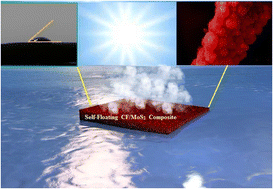A hydrophilic carbon foam/molybdenum disulfide composite as a self-floating solar evaporator†
Abstract
Solar-driven interfacial evaporation has gained increasing attention as an emerging and sustainable technology for wastewater treatment and desalinization. The carbon/molybdenum disulfide (C/MoS2) composite has attracted more attention due to its outstanding light absorption capability and optoelectronic properties as a solar steam generator. However, the hydrophobic nature of carbon and MoS2-based materials hinders their wettability, which is crucial to the effective and facile operation of a solar generator of steam. Herein, a pH-controlled hydrothermal method was utilized to deposit a promising photothermal MoS2 coating on melamine-derived carbon foams (CFs). The hydrophilic CF/MoS2 composite, which can easily be floatable on the water surface, is a high-efficiency solar steam evaporator with a rapid increase in temperature under photon irradiation. Due to the localized heat confinement effect, the self-floating composite foam on the surface of water has the potential to produce a significant temperature differential. The porous structure effectively facilitates fast water vapor escape, leading to an impressively high evaporation efficiency of 94.5% under a light intensity of 1000 W m−2.



 Please wait while we load your content...
Please wait while we load your content...